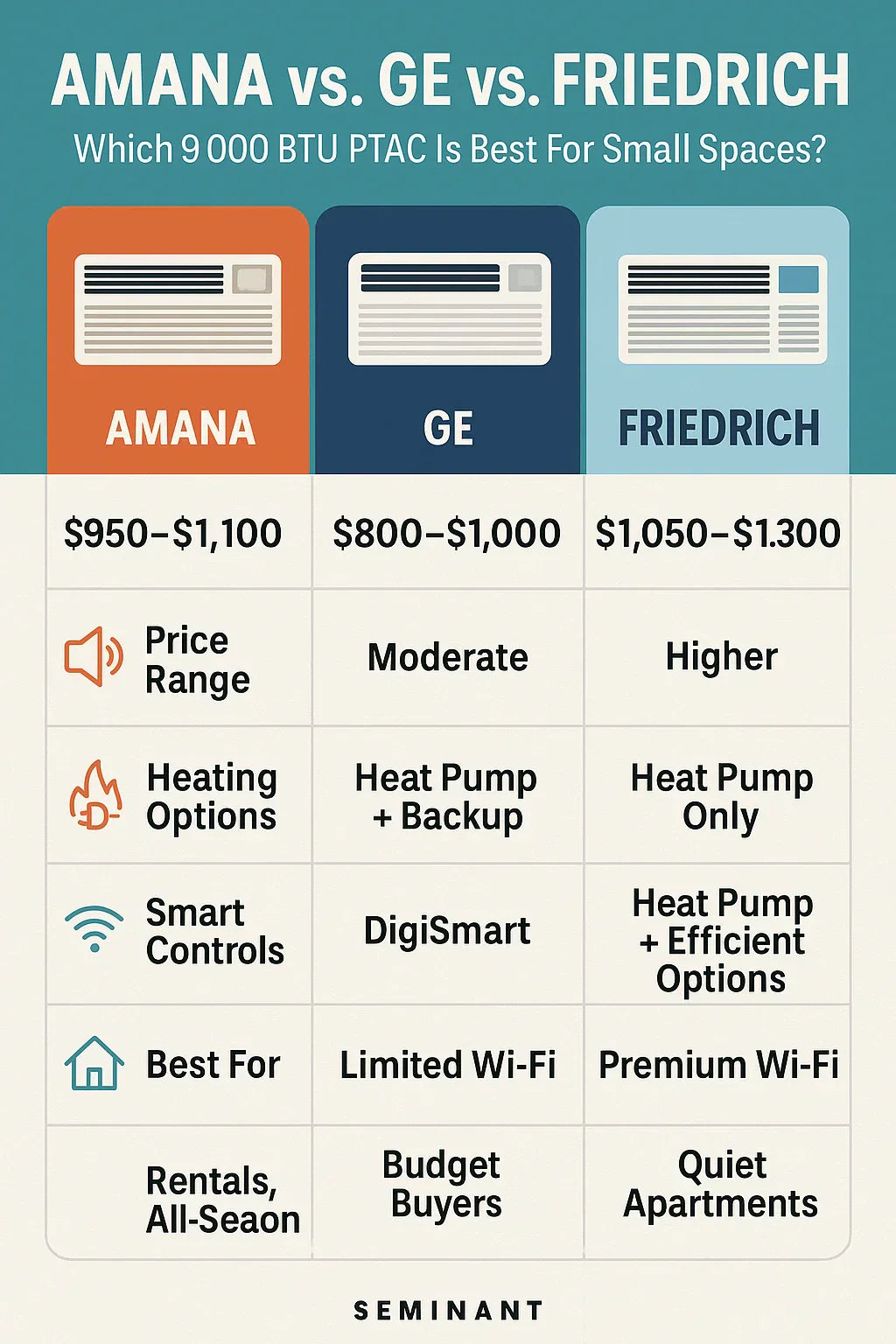When my cousin asked me to help pick a PTAC unit for her Airbnb studio, I thought the hardest part would be figuring out the right size. After all, PTACs come in a range of BTUs. But once we settled on 9,000 BTUs—perfect for a 300–400 sq. ft. room—the real challenge began: choosing between Amana, GE, and Friedrich.
Amana Distinctions 9,000 BTU PTAC Heat Pump with 2.5 kW Electric Heat Backup
Each brand has a solid reputation, but they excel in different ways—efficiency, noise, reliability, and price. If you’re looking for a 9,000 BTU PTAC for a guest room, studio, or small apartment, this guide will help you make the right call.
🌬️ Why 9,000 BTUs Is the Sweet Spot
Before we dive into brand comparisons, let’s confirm why 9,000 BTUs makes sense for small spaces:
-
Ideal for 300–450 sq. ft. rooms (guest rooms, studios, offices).
-
Efficient—doesn’t overcool or overheat.
-
Compact size keeps noise and energy costs manageable.
👉 Samantha’s tip: “I always recommend right-sizing. Oversized units waste energy and cycle on and off too often.”
🔗 Reference: Energy.gov – Room AC Sizing.
🧱 Amana 9,000 BTU PTAC
Amana has been a leader in PTAC units for decades, especially in the hospitality industry.
🔹 Strengths
-
Heat pump + backup heat option – ensures year-round comfort, even in freezing weather.
-
DigiSmart controls – optional smart upgrade with Wi-Fi and energy management.
-
Durability – designed for heavy daily use in hotels and rentals.
-
Warranty – 5 years parts and labor (with extended coverage options).
🔹 Best For
-
Rentals (Airbnb, hotels, senior housing).
-
Homeowners in cold or variable climates.
-
Anyone wanting peace of mind with backup heating.
👉 Samantha’s story: “The Amana won me over because of the backup heat. For my cousin’s studio, guests were comfortable even when temps dipped below freezing.”
🔗 Reference: Amana PTAC Product Line.
⚡ GE 9,000 BTU PTAC
GE offers budget-friendly PTACs that are widely available.
🔹 Strengths
-
Lower upfront cost – generally $100–$200 less than Amana.
-
Energy efficiency – many models meet Energy Star standards.
-
Simple, user-friendly controls.
-
Widely available parts and service.
🔹 Weaknesses
-
Noise level – GE units tend to be louder than Amana or Friedrich.
-
Limited smart controls – Wi-Fi available but less advanced than Amana DigiSmart.
🔹 Best For
-
Budget-conscious buyers.
-
Warm-weather regions where backup heat isn’t critical.
-
Guest rooms where cost matters more than premium features.
👉 Samantha’s perspective: “If budget was my only concern, GE would have been the pick. It’s solid, but the noise factor made me think twice.”
🔗 Reference: GE Appliances PTAC Units.
🔇 Friedrich 9,000 BTU PTAC
Friedrich is known for premium quality and quiet performance.
🔹 Strengths
-
Noise reduction design – Friedrich PTACs are the quietest of the three.
-
Premium controls – advanced Wi-Fi, programmable scheduling.
-
Strong efficiency – higher EER/CEER ratings in some models.
-
High build quality – fewer repairs, long lifespan.
🔹 Weaknesses
-
Higher upfront cost – often $200–$300 more than Amana.
-
Parts availability – sometimes harder to source depending on region.
🔹 Best For
-
Home offices or bedrooms where quiet operation is critical.
-
Homeowners wanting premium feel and controls.
-
Small apartments where residents use the PTAC daily.
👉 Samantha’s note: “If I were buying for my own home office, I’d pick Friedrich. The quiet operation is worth it when you’re working or sleeping nearby.”
🔗 Reference: Friedrich PTAC Systems.
📊 Side-by-Side Comparison
| Feature | Amana | GE | Friedrich |
|---|---|---|---|
| Price Range | $950–$1,100 | $800–$1,000 | $1,050–$1,300 |
| Noise Level | Moderate | Higher | Low |
| Heating Options | Heat Pump + Backup | Heat Pump Only | Heat Pump (efficient, quiet) |
| Smart Controls | DigiSmart Wi-Fi | Limited Wi-Fi | Premium Wi-Fi |
| Warranty | 5 Years | 1 Year Standard | 2–5 Years |
| Best For | Rentals, Cold Climates | Budget Buyers | Quiet Apartments & Offices |
💰 Cost of Ownership
While upfront costs vary, total ownership costs matter most.
-
Amana: Higher upfront than GE but efficient, with backup heat savings in winter.
-
GE: Cheapest upfront but may cost more in energy and maintenance long term.
-
Friedrich: Highest upfront, but premium build reduces service calls.
🔗 Reference: HVAC.com – PTAC Costs.
🛠️ Maintenance & Service
-
Amana: Widely available parts and service networks.
-
GE: Easy to find service, but units may require more frequent maintenance.
-
Friedrich: Excellent reliability, but parts may need to be ordered from specific suppliers.
🔗 Reference: ASHRAE – HVAC Reliability Standards.
🌍 Energy Efficiency
-
Amana: CEER ~9.5–9.8, solid mid-range.
-
GE: CEER ~9.0–9.6, depending on model.
-
Friedrich: CEER ~10.0–10.5, often the most efficient.
Over 10 years, Friedrich may save ~$200–$300 more in energy bills compared to GE.
🔗 Reference: Energy Star – Room AC Ratings.
✅ Key Takeaways
-
Choose Amana if you need reliability and backup heat for rentals or cold-weather use.
-
Choose GE if your priority is budget-friendly pricing and you live in a mild climate.
-
Choose Friedrich if you want quiet operation and premium controls for personal spaces.
👉 Samantha’s verdict: “For my cousin’s Airbnb, I picked Amana—it struck the right balance of reliability, backup heat, and cost. But if it had been for my home office, I’d have gone with Friedrich.”
In the next topic we will know more about: Do PTAC Units Qualify for Energy Rebates or Tax Credits in 2025?







